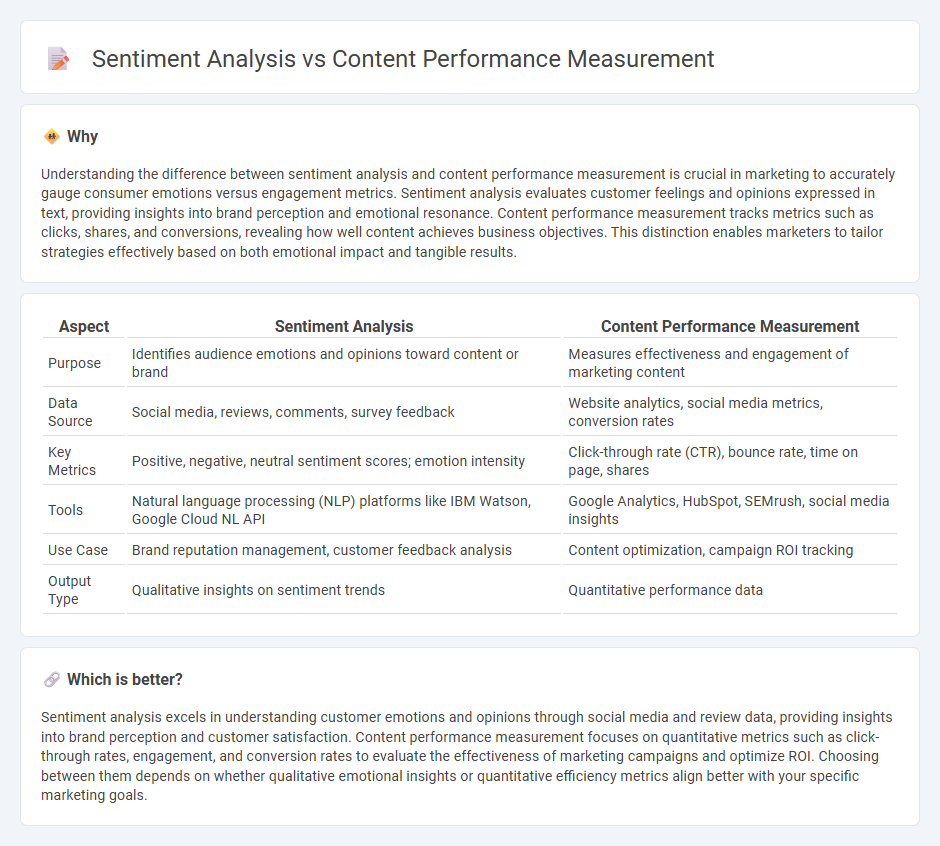
Sentiment analysis evaluates customer emotions by analyzing text data from reviews, social media, and surveys, providing insights into brand perception and consumer attitudes. Content performance measurement tracks metrics such as engagement rates, click-through rates, and conversions to determine the effectiveness of marketing campaigns and content strategies. Explore deeper how combining these approaches can enhance marketing insights and strategy optimization.
Why it is important
Understanding the difference between sentiment analysis and content performance measurement is crucial in marketing to accurately gauge consumer emotions versus engagement metrics. Sentiment analysis evaluates customer feelings and opinions expressed in text, providing insights into brand perception and emotional resonance. Content performance measurement tracks metrics such as clicks, shares, and conversions, revealing how well content achieves business objectives. This distinction enables marketers to tailor strategies effectively based on both emotional impact and tangible results.
Comparison Table
| Aspect | Sentiment Analysis | Content Performance Measurement |
|---|---|---|
| Purpose | Identifies audience emotions and opinions toward content or brand | Measures effectiveness and engagement of marketing content |
| Data Source | Social media, reviews, comments, survey feedback | Website analytics, social media metrics, conversion rates |
| Key Metrics | Positive, negative, neutral sentiment scores; emotion intensity | Click-through rate (CTR), bounce rate, time on page, shares |
| Tools | Natural language processing (NLP) platforms like IBM Watson, Google Cloud NL API | Google Analytics, HubSpot, SEMrush, social media insights |
| Use Case | Brand reputation management, customer feedback analysis | Content optimization, campaign ROI tracking |
| Output Type | Qualitative insights on sentiment trends | Quantitative performance data |
Which is better?
Sentiment analysis excels in understanding customer emotions and opinions through social media and review data, providing insights into brand perception and customer satisfaction. Content performance measurement focuses on quantitative metrics such as click-through rates, engagement, and conversion rates to evaluate the effectiveness of marketing campaigns and optimize ROI. Choosing between them depends on whether qualitative emotional insights or quantitative efficiency metrics align better with your specific marketing goals.
Connection
Sentiment analysis provides valuable insights into audience emotions and opinions, enabling marketers to tailor content strategies effectively. Measuring content performance through metrics such as engagement rates, click-through rates, and conversion rates helps validate the impact of sentiment-driven content adjustments. Integrating sentiment analysis with performance measurement enhances the precision of marketing campaigns by aligning messaging with audience preferences and improving ROI.
Key Terms
**Content Performance Measurement:**
Content performance measurement assesses metrics such as engagement rates, click-through rates, conversion rates, and time spent on page to evaluate the effectiveness of digital content. It provides actionable insights into audience behavior and content ROI by analyzing quantitative data from tools like Google Analytics and social media platforms. Explore more to understand how data-driven strategies can enhance your content's impact.
Engagement Rate
Engagement rate measures content performance by quantifying user interactions such as likes, comments, shares, and clicks, providing direct insights into audience involvement. Sentiment analysis evaluates the emotional tone behind user feedback, offering qualitative context about how audiences perceive the content. Explore how combining engagement metrics with sentiment insights can elevate your content strategy effectiveness.
Conversion Rate
Content performance measurement tracks metrics such as Conversion Rate to evaluate how effectively content drives desired user actions, directly impacting marketing ROI. Sentiment analysis, analyzing user emotions and opinions, provides qualitative insights but does not directly quantify conversion outcomes. Explore deeper to understand how integrating both approaches can optimize your content strategy and boost Conversion Rate.
Source and External Links
Measure Content Performance in 7 Steps - Mightybytes - This guide outlines seven essential steps for measuring content performance, starting with revisiting content goals and selecting key performance indicators (KPIs) aligned to those goals, to track and improve content effectiveness over time.
Content Scoring: Measure & Improve Content | Acrolinx - Content scoring is described as a data-driven method that assigns scores based on metrics like readability, SEO, engagement, and conversions, enabling organizations to evaluate, measure, and optimize content quality and performance systematically.
What does content performance mean? A definition. - Bynder - Content performance measures how well content outcomes align with marketing objectives and provides data-driven insights that help optimize, validate, or retire content based on its effectiveness at meeting business goals.
 dowidth.com
dowidth.com